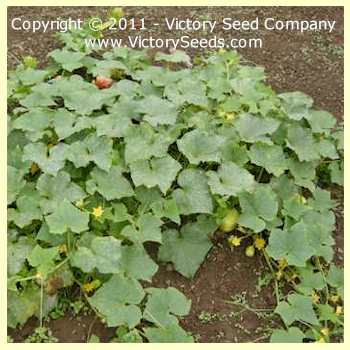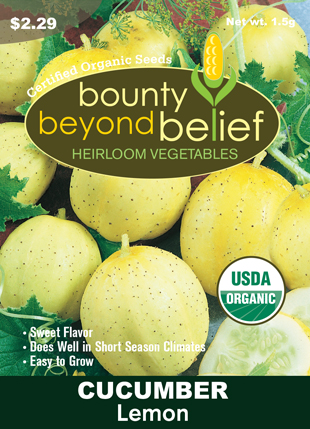The information on this page applies to seedlings sold by LEAF Nursery during our 2021 Seedling Sale.

Cucumis sativus. These Lemon cucumbers are small, round and yellow with a bright, sweet flavor that traditional cucumbers lack. With a thin skin and unique shape they can be eaten just like an apple. Add color to your garden and your table; try them sliced, in salads or in cold water as a refreshing drink. Easy to grow and prolific, this heirloom variety is great for areas with short growing seasons.[1]

Seed Type
| Organic | Heirloom | Non-GMO | Hybrid | Open-pollinated | Untreated |
Additional Information
| Container Friendly | Trellis Recommended | Easy to Grow | Pollinator Friendly |
When to Plant Your Seedling
| Jan | Feb | Mar | Apr | May | Jun | Jul | Aug | Sep | Oct | Nov | Dec |
Growing Conditions
| Light | Temperature | Soil | Water |
|---|---|---|---|
| Full Sun | 75-90 F | Rich well drained soil | Average water |
Planting Tips
| Plant Spacing | Plant Size | Days to Maturity |
|---|---|---|
| 58-70 days from seed |
- Additional instructions: Cucumbers require rich, well-drained soil, a long rotation cycle (don't plant them in the same spot year after year), consistent moisture and proper spacing help reduce stress on plants and avoidance of common cucumber diseases like scab and mosaic. Cucumbers, corn and beans grow very well when planted together. All three of these vegetables love warmth, rich soil and adequate moisture. Cucumbers also form a great duet with sunflowers using the sunflowers for strong support for the vines. Cucumbers do not like sage, potatoes or rue. Lemon Cucumber which looks vaguely like a lemon was introduced around 1894. They are very mild with a novel color and shape.[1]
- Most varieties of cucumber vines spread from row to row. Training on a cage, trellis or fence along the edge of the garden will correct this and also lift the fruit off the soil. Trellising gets leaves up off the ground so that they dry off faster. Also, if the vines are trellised, the gardener is less likely to step on the vines and there is no need to move the vines for weeding or other purposes, reducing the risk of damage. If trellising is not possible, there are many excellent bush varieties of cucumber available now. Most of them produce well for a limited amount of space and may be a desirable alternative in a small garden. If vines are not trellised, avoid destroying blossoms or kinking vines by gently rolling the vines away rather than lifting them when searching for harvestable fruit. In non-trellised plantings, organic materials are useful in the summer to return moisture and keep the fruit clean. Working in the vines when leaves are wet could spread disease. Wait until after morning dew or rain evaporates. There has been a significant increase in disease resistance in cucumber varieties in recent years. Select resistant varieties when possible[2]
- Harvesting instructions: Harvest cucumbers when they are about 2 inches long up to any size before they begin to turn yellow. Remove fruits by turning cucumbers parallel to the vine and giving a quick snap because it prevents vine damage and results in a clean break.[2]
Common Diseases and Pests
- Aphids, Spidermites, Whiteflies, Leafhoppers, Leafmines, Cucumber Beetle, Squash Bug, Nematodes, Angular Leafspot, Powdery Mildew, Downy Mildew, Mosaic Virus, Verticillium wilt, Sudden wilt, and Belly Rot[2]
Useful Resources
- https://bbbseed.com/product/cucumber-lemon-org/(Seed Source)
- https://vric.ucdavis.edu/pdf/cucumber.pdf
- https://sfbaygardening.com/resources/bay-area-planting-calendar/
If you bought this seedling and have any questions or feedback, let us know in the comment section below.